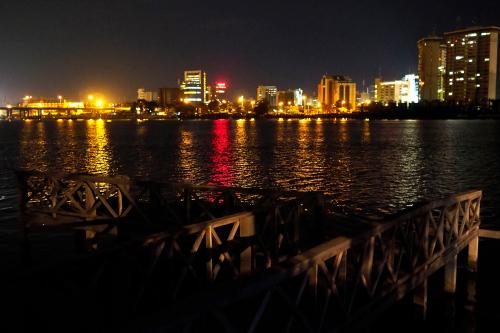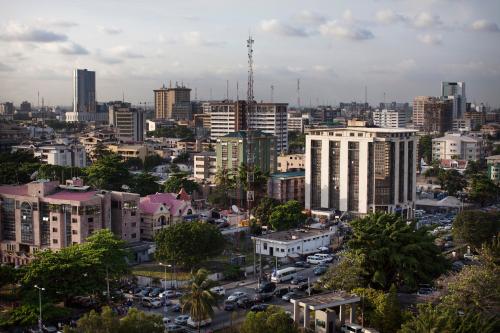Sub-Saharan Africa is urbanizing rapidly but remains mostly rural. Already, cities such as Lagos and Kinshasa constitute urban agglomerations of over 10 million residents (“megacities”), while Dar-es-Salaam, Johannesburg, and Luanda are projected to reach that size by 2030. This rapid city growth in sub-Saharan Africa reflects trends across all developing nations. In 1950, most of the world’s largest cities were in rich countries, but by 2015 nearly all were in low-income nations (Figure 1).
The Rise of Poor Mega-Cities in Developing Nations

This massive population shift—dubbed the rise of poor megacities—creates both profound opportunities and challenges. Access to jobs, public goods, infrastructure, and health care are better in cities. However, if city populations continue to grow without economic transformation, a vicious and persistent cycle of high fertility, low wages, and persistent poverty could result. In June, the World Bank convened a conference of economic experts to discuss urbanization in Africa. In his opening remarks, Harvard University Professor of Economics Edward Glaeser noted: “Cities are the best path we know out of poverty. They are the best transformers of civilizations. But, there are also demons that come with density.”
Here we describe the causes of Africa’s rapid urbanization and outline which policies can avoid these demons to transform the region’s growing cities into engines of economic growth.
Explosive city growth in sub-Saharan Africa
Sub-Saharan Africa’s urbanization rate went from 15 percent in 1960—approximately the same as 1600s Europe—to 38 percent today, which is higher than South Asia. The number of urban residents in Africa nearly doubled between 1995 and 2015 and is projected to almost double again by 2035.
Infrastructure and service delivery have not kept pace: Over 50 percent of urban dwellers in sub-Saharan Africa live in slums and only 40 percent of the urban population has access to improved sanitation facilities, a rate that has not changed since 1990. Moreover, Africa’s fertility rate is substantially higher than other regions (Figure 2), which means that the urban child dependency ratio is 40 percent higher than Latin America and 65 percent higher than Asia.
Regional comparison of urban development indicators
 Source: Author’s visualizations of World Bank Development Indicators 2016.[1]
Source: Author’s visualizations of World Bank Development Indicators 2016.[1]
Urbanization without structural transformation
Fundamentally, city size is determined through the balance between the positive and negative forces of population density. The economic benefits of urbanization include agglomeration economies that raise workers’ and businesses’ productivity through enhanced resource sharing, quicker and better job matching, faster knowledge spillovers, infrastructure access, public goods, and lower transaction costs. The productivity advantage of greater density is likely even larger in developing nations—partly due to more pervasive market failures. Models of structural transformation, which describe how economies move from agricultural to industrial production, explain city growth as a consequence of labor push and pull factors. Push factors refer to increased agricultural productivity or crop failures releasing rural labor to cities, while pull factors include urban industrial development attracting agricultural workers with higher wages.
However, these processes alone cannot explain sub-Saharan Africa’s rapid urbanization since 1960. Unlike in other parts of the world, there has not been substantial improvement in agricultural productivity that could constitute a green revolution. Nor has there been a significant industrial revolution to populate cities. Instead, Africa is leapfrogging over the industrial phase of development with the service sector driving growth and constituting almost 60 percent of regional GDP in 2014. In addition, Africa’s formal sector plays a limited role in absorbing urban labor. Instead, the share of informal work in non-agricultural employment is more than 50 percent in 7 of the 10 reporting countries.
If not the above push-pull factors, another explanation for increasing urbanization is economic growth through natural resource extraction. Commodity production creates rents and increases demand for non-tradable urban goods and services—raising urban population levels but generating low-productivity, and often informal or service-sector jobs. Meanwhile, export earnings raise currency exchange rates and stifle industrial production. A study by Remi Jedwab shows how historical cocoa production in Côte d’Ivoire and Ghana drove city growth there. Jedwab dubs the result “consumption cities” because they grow based on spending from natural resources production in contrast to cities that expand with increasing productivity.
Urbanization through political pull
Political relationships have also affected African urbanization, particularly population concentration in a single primate city. Politics can impact location choices because proximity to power increases political influence. As the number of lobbyists on Washington D.C.’s K Street suggests, closeness can translate into greater rents and resources for the capital city. One study found that autocratic governments across the world had 50 percent larger primate cities than democracies. Indeed, the population distribution in sub-Saharan Africa does indeed exhibit a higher population concentration in primate cities, such that political capitals are larger than what is expected from other countries. Moreover, recent research tests whether the wave of democratization in sub-Saharan Africa since the 1990s reduced population concentration and finds significant catch-up growth in non-capital cities.
Urbanization through health improvements
In addition to natural resource extraction and politics, urbanization in developing countries is also driven by the discovery and dissemination of health technologies. Historically, moving to cities required a trade-off between better economic opportunities, but lower life expectancy. For example, large cities in the U.S. experienced very high death rates from infectious disease and lower overall life expectancy compared to rural areas until the 1940s. The threat of industrial pollution persisted even later with the Great London Fog of 1952-1953 contributing to 12,000 excess deaths.
However, rapidly decreasing mortality rates in developing nations after World War II shifted the balance of forces driving city growth. Instead of the “killer cities” of the past, improved health care allowed for higher population density for a given income level. A recent study compares mortality by city size in late-1800s England to modern day China and found that larger English cities were more deadly than smaller ones, while bigger Chinese cities today experience lower mortality than their smaller counterparts. In addition, the study explores the relationship between industrial pollution and mortality, finding that the association between pollution and deaths was much stronger in industrial England than contemporary China. Moreover, data from 73 developing nations mostly in sub-Saharan Africa shows that child health is better in urban slums than rural areas (although substantially worse than formal settlements in urban areas).
Since 2000, a remarkable health transition has transformed mortality in sub-Saharan Africa. Infant mortality in the region has declined by 40 percent, while the dissemination of antiretroviral therapy reduced HIV-related mortality in the region by 48 percent between 2004 and 2014. Meanwhile, malaria control efforts such as distribution of insecticide-treated bed nets, indoor residual spraying, and malaria drug prophylaxis have decreased malaria-related mortality by over 50 percent.
Over the same period, the World Bank estimates that sub-Saharan Africa’s total fertility rate has decreased by 14 percent. Urban fertility rates in the region are 1-3 children per woman lower than in rural areas, but still double replacement in eastern and western Africa. Southern Africa and select nations in east Africa exhibit urban fertility rates trending toward replacement, but the fertility transition has progressed slowly overall. In the past, mortality decline has played an important role in decreasing fertility, as parents adjust their desired fertility to fewer infant deaths. Thus, the recent mortality declines without an equivalent fertility transition have increased city population growth, pressured rural economies, and spurred rural to urban migration.
Policy recommendations
Sub-Saharan Africa has experienced an unprecedented period of health improvement in the last 15 years. This success has shifted African settlement toward cities, raising the possibility of permanently poor slums, but creating unprecedented opportunities for economic transformation as well. We outline the following five policy recommendations to maximize the likelihood that Africa’s urbanization will produce lasting economic gains, while mitigating the demons of density caused by rapid urbanization.
- Encourage productive cities: Of the above-listed mechanisms driving African urbanization, only improved health represents an opportunity for macroeconomic growth, but these human capital investments must be coupled with structural transformation to be sustainable. This can be achieved by encouraging shifts away from the informal sector and toward higher productivity services. Currently, cities in developing nations are far less functionally differentiated than their rich-world counterparts. To encourage location-specific specialization, favorable lending and tax incentives to promote business clustering as well as stronger transportation links would raise productivity.
- Strengthen secondary cities: Currently much policy discussion is focused on whether to promote either rural or urban development. This debate should shift to the type of urban development. Rural poverty alleviation more frequently occurs through movement to the rural non-farm economy or migrating to nearby smaller secondary towns. This trend allows workers to enter the formal economy and bear the risks of migration without losing access to informal support networks. Greater decentralization of power and economic activity in sub-Saharan Africa represents an important tool for further development. With greater political autonomy and access to capital, secondary cities will be better able to provide high quality services.
- Continued investments in demographic transition: No nation has developed without going through a demographic transition that began with reduced mortality. Ensuring that the recent large mortality declines and shift to cities in Africa continues to reduce fertility is essential for economic transformation. In addition to sustained health investments, since returns to schooling at all levels are higher in sub-Saharan Africa and higher still for girls, greater access to schooling for girls and women would also speed this transition.
- Promote in situ upgrading of slum housing: Given the high level of slum dwelling in Africa’s cities, policies to upgrade settlements will improve welfare, raise labor demand, and promote demographic transition through better child health.
- Take advantage of new data sources. Weak data collection systems limit our knowledge of African urbanization and poverty. New data sources such as satellite images of night lights, daytime satellite pictures, Google Street View, and mobile phone networks can increasingly be used to measure migration, city size, and economic growth in order to better target funding and rapidly measure policy effectiveness.
[1] Urbanization refers to the proportion of people living in urban areas. Urban slum dwelling refers to the proportion of the urban population living in slum households, where a slum household is defined as a group of individuals living under the same roof lacking one or more of the following conditions: access to improved water, access to improved sanitation, sufficient living area, and durability of housing. Urban improved sanitation refers to the percentage of the urban population using improved sanitation facilities. Improved sanitation facilities are likely to ensure hygienic separation of human excreta from human contact, and include flush/pour flush (to piped sewer system, septic tank, pit latrine), ventilated improved pit (VIP) latrine, pit latrine with slab, and composting toilet. Total fertility rate refers to the number of births a woman would have if she passed through her childbearing years having children according to the current level of age-specific of fertility rates. We calculated total fertility as a percent of sub-Saharan Africa’s by dividing the total fertility rates of each region by the total fertility rates of sub-Saharan Africa.









Commentary
Can rapid urbanization in Africa reduce poverty? Causes, opportunities, and policy recommendations
September 7, 2016